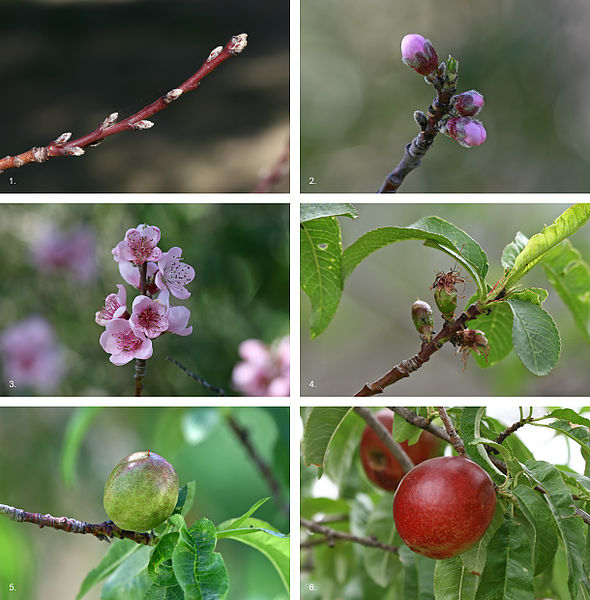Datoteka:Nectarine Fruit Development.jpg

Veličina ovog prikaza: 590 × 600 piksela. Ostale rezolucije: 236 × 240 piksela | 472 × 480 piksela | 756 × 768 piksela | 1.007 × 1.024 piksela | 2.440 × 2.480 piksela.
Izvorna datoteka (2.440 × 2.480 piksela, veličina datoteke: 919 KB, MIME tip: image/jpeg)
Historija datoteke
Kliknite na datum/vrijeme da vidite verziju datoteke iz tog vremena.
| Datum/vrijeme | Smanjeni pregled | Dimenzije | Korisnik | Komentar | |
|---|---|---|---|---|---|
| trenutno | 13:21, 6 juni 2008 |  | 2.440 × 2.480 (919 KB) | Jjron | {{Information |Description=Nectarine (''Prunus persica'') fruit development over a 7½ month period, from early winter to midsummer; East Gippsland, Victoria, Australia. #Bud formation can be observed on new growth on the plant (early winter) ([[:Image:0 |
| 13:14, 6 juni 2008 |  | 2.440 × 2.480 (919 KB) | Jjron | {{Information |Description=Nectarine (''Prunus persica'') fruit development over a 7½ month period, from early winter to midsummer; East Gippsland, Victoria, Australia. #Bud formation can be observed on new growth on the plant (early winter) ([[:Image:0 | |
| 15:00, 24 mart 2008 |  | 2.440 × 2.480 (993 KB) | Jjron | {{Information |Description=Nectarine fruit development over a 4½ month period, from early September 2007 to mid January 2008; East Gippsland, Victoria, Australia. #. Flower buds form and leaves start to develop.<br> #. Flowers fully develop and are poll |
Upotreba datoteke
Sljedeća stranica koristi ovu datoteku:
Globalna upotreba datoteke
Sljedeći wikiji koriste ovu datoteku:
- Upotreba na arc.wikipedia.org
- Upotreba na ar.wikipedia.org
- Upotreba na ast.wikipedia.org
- Upotreba na ast.wiktionary.org
- Upotreba na ba.wikipedia.org
- Upotreba na be-tarask.wikipedia.org
- Upotreba na bg.wikipedia.org
- Upotreba na bn.wikipedia.org
- Upotreba na bo.wikipedia.org
- Upotreba na crh.wikipedia.org
- Upotreba na cv.wikipedia.org
- Upotreba na diq.wikipedia.org
- Upotreba na dsb.wikipedia.org
- Upotreba na en.wikipedia.org
- Fruit
- Peach
- Drupe
- Prunus
- User:Jjron
- User talk:Jjron/Archive 3
- Wikipedia:Featured pictures thumbs/11
- Wikipedia:Featured pictures/Plants/Fruits
- Wikipedia:Featured picture candidates/June-2008
- Wikipedia:Featured picture candidates/Image:Nectarine Fruit Development.jpg
- Wikipedia:Wikipedia Signpost/2008-06-23/Features and admins
- User:Jjron/Gallery/Plants
- User:Jjron/Gallery/FPs
- Wikipedia:Wikipedia Signpost/2008-06-23/SPV
- Wikipedia:Picture of the day/December 2008
- Template:POTD/2008-12-11
- Wikipedia talk:2008 main page redesign proposal/Archive 4
- Wikipedia:WikiProject Food and drink/Recognized content
- Wikipedia:WikiProject Food and drink/Showcase
- Wikipedia:WikiProject Food and drink/Showcase/FM
- Wikipedia:WikiProject Food and drink/Showcase/POTD
- User:Abyssal/bla
- Wikipedia:WikiProject Plants/Recognized content
- Portal:Plants/Recognized content
- User:Haoreima/List of Meitei plant common names
- Wikipedia:Wikipedia Signpost/Single/2008-06-23
- Upotreba na en.wikiversity.org
- Upotreba na eo.wikipedia.org
- Upotreba na es.wikipedia.org
- Upotreba na fa.wikipedia.org
- Upotreba na fr.wikipedia.org
Pogledajte globalne upotrebe ove datoteke.


